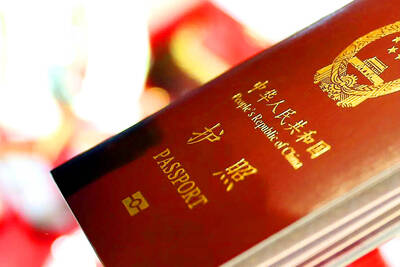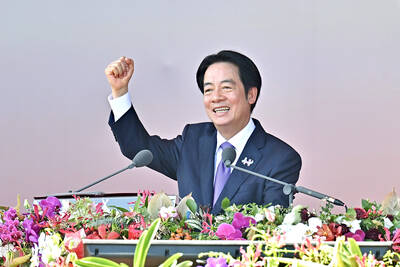With China now believed to be working on a new guided-missile destroyer, a US military expert is advising Taiwan to rethink the island’s naval strategy.
“Taipei must admit defeat in the arms race — and then work around it,” said James R. Holmes, associate professor of strategy at the US Naval War College.
He said that the “apparent emergence” of China’s Type 052D guided-missile destroyer (DDGs) — reported last month in the Taipei Times — “reinforces the case” for revising Taiwan’s naval strategy.
“With sixteen frontline DDGs, the PLA [People’s Liberation Army] Navy will command overwhelming superiority in numbers over the ROC [Republic of China] Navy’s four elderly Kidd-class DDGs, which are hand-me-downs from the Cold War era-US Navy,” Holmes said.
Writing on The Naval Diplomat Web site, Holmes said Beijing’s 052D destroyer may “outclass” Taiwan’s ships.
“Both quality and sheer weight of numbers are on China’s side in the cross-strait naval competition,” he said.
In addition, an “economically outmatched” Taiwan that cannot manufacture or import state-of-the-art warships stands little chance of “reversing the momentum.”
He added: “This demands a change of mindset.”
Guided-missile destroyers like the 052D are “sea-control” vessels meant to “clear the seas of enemy fleets.”
However, despite Taiwan’s weaker navy, its commanders and their “political masters” still have options if they admit they are the weaker side and devise strategy accordingly” Holmes said, adding that “the weak sometimes prevail if they set limited goals and align their meager means to those goals.”
Holmes believes that Taiwan should invest in relatively inexpensive missile-equipped patrol craft and submarines that can fight even against technologically and numerically superior foes.
“The logic of sea denial is compelling for forces protecting their home turf,” he said.
According to Holmes, Taipei took some “baby steps” toward sea-denial capability with its Kuang Hua V1 fast patrol boats and is “reportedly developing a stealth corvette that looks like a truly impressive war-fighting implement.”
Equipped with these patrol boats and corvettes, the navy could “turn the logic of sea denial against the mainland” keeping it out of vital waters and driving up the costs of entry “to unbearable heights.”
Holmes added that “with swarms of sea-denial assets, the nation’s defenders would stand a good chance of giving any cross-strait invasion force nightmares, or, better yet, of deterring the attempt altogether and Taiwan’s chances of defying coercion would brighten commensurately.”

The Ministry of the Interior (MOI) is to tighten rules for candidates running for public office, requiring them to declare that they do not hold a Chinese household registration or passport, and that they possess no other foreign citizenship. The requirement was set out in a draft amendment to the Enforcement Rules of the Public Officials Election and Recall Act (公職人員選舉罷免法 ) released by the ministry on Thursday. Under the proposal, candidates would need to make the declaration when submitting their registration forms, which would be published in the official election bulletin. The move follows the removal of several elected officials who were

FOUR DESIGNATED AREAS: Notices were issued for live-fire exercises in waters south and northwest of Penghu, northeast of Keelung and west of Kaohsiung, they said The military is planning three major annual exercises across the army, navy and air force this month, with the navy’s “Hai Chiang” (海強, “Sea Strong”) drills running from today through Thursday, the Ministry of National Defense said yesterday. The Hai Chiang exercise, which is to take place in waters surrounding Taiwan, would feature P-3C Orion maritime patrol aircraft and S-70C anti-submarine helicopters, the ministry said, adding that the drills aim to bolster the nation’s offshore defensive capabilities. China has intensified military and psychological pressure against Taiwan, repeatedly sending warplanes and vessels into areas near the nation’s air defense identification zone and across

SENATE RECOMMENDATION: The National Defense Authorization Act encourages the US secretary of defense to invite Taiwan’s navy to participate in the exercises in Hawaii The US Senate on Thursday last week passed the National Defense Authorization Act (NDAA) for Fiscal Year 2026, which strongly encourages the US secretary of defense to invite Taiwan’s naval forces to participate in the Rim of the Pacific (RIMPAC) exercise, as well as allocating military aid of US$1 billion for Taiwan. The bill, which authorizes appropriations for the military activities of the US Department of Defense, military construction and other purposes, passed with 77 votes in support and 20 against. While the NDAA authorizes about US$925 billion of defense spending, the Central News Agency yesterday reported that an aide of US

NATIONAL DAY: The ‘Taiwan Dome’ would form the centerpiece of new efforts to bolster air defense and be modeled after Israel’s ‘Iron Dome,’ sources said President William Lai (賴清德) yesterday pledged to strengthen the nation’s air defense capabilities and build a “T-Dome” system to create a safety net against growing military threats from China. “We will accelerate our building of the T-Dome, establish a rigorous air defense system in Taiwan with multi-layered defense, high-level detection and effective interception, and weave a safety net for Taiwan to protect the lives and property of citizens,” he said in his National Day address. In his keynote address marking the Republic of China’s (ROC) 114th anniversary, Lai said the lessons of World War II have taught nations worldwide “to ensure that